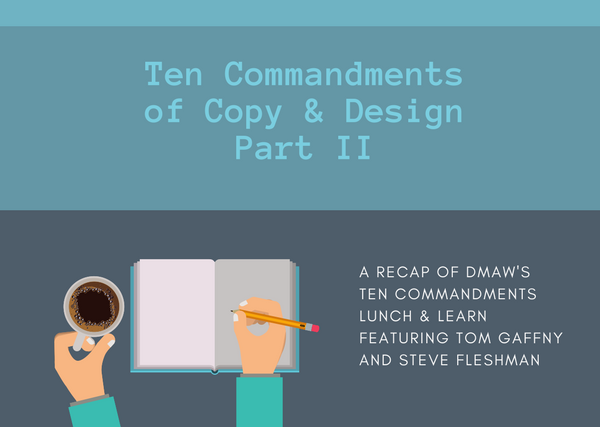Ten Commandments of Copy & Design Part II

You Still Can’t Risk NOT Reading This!
(Continuing on with a quick wrap up of DMAW’s Ten Commandments Lunch & Learn featuring Tom Gaffny and Steve Fleshman.)
Among the Commandments according to Tom and Steve is NEVER break a multi-page letter with the end of a sentence. Entice the reader to turn the page and read on.
Much like I hopefully enticed you to read this second blog with the way I ended the first blog by starting but not completing one of the Commandments.
Commandment Number 6 – Whack Them Over the Head with an Interrupting Thought – Up Front.
“Up front,” is the key term here. This doesn’t mean suddenly in the middle of your letter or email change the subject. That would not be good. It means make the lead, teaser or subject line
memorable, attention grabbing, and impossible to ignore.
One example Tom gave was a lead that began, “I saw God the other day.”
The letter – which uses dialogue as a technique you might want to test – goes on to explain the boy saying that line, saw God in the faces of all the other children the donor helps.
Commandment Numbers 7 & 8 – Ask Early & Often, on the Most Important Elements of Direct Marketing Messages
So, what is the most important piece of any direct marketing message? The carrier, the teaser, the letter, the lead, the ask, the P.S., the reply device, and likewise in emails, the subject line, the call to action?
They all are.
But most importantly is the ask.
You are in the fundraising business, so ask early. The higher up your ask, the more likely people are to respond. It’s okay to even lead with an ask in cases where that makes sense. Even though a MAXI winner this year had it’s first ask on page 10, that is NOT the norm. Have at least one ask on page one of any letter, and above the fold on any email. And when designing emails, think mobile. You may have just the size of your phone screen to get the donor to act.
Also, remember what Tom calls the “consequences of inaction” rule.
“None of our work would be possible without the financial help of people like you.”
Don’t be afraid to tell them what horrible things could happen if they don’t respond immediately.
It’s also important to make the ask reasonable to the impact the donor can make. Some examples given: “You can’t cure cancer. But you can help rescue one child who is fighting it.” Or “You can’t end world hunger. But you can feed a child.”
Commandment Number 9 – Remember Aretha: R.E.S.P.E.C.T.
(If you’re too young to remember Aretha, ask a coworker born before 1990.)
Approach every message with an air of humility about you. Respect your donor. Respect their value in your organization’s ability to do its work. And tell them how much you value them.
Along these lines, “slick is your enemy,” as Steve explained. If you can afford to send out a sleek marketing piece, why do you need the donor’s $25?
Again, make your mail and email look real. Add something that makes it look like it doesn’t come from a machine. Test purposeful mistakes, or ink smears.
Speak to the person you are writing to. But do it in the same way you speak.
That preposition at the end of the sentence is not a concern when people are dying, or wildlife and wildlands are in danger and in need of immediate help.
Commandment Number 10 – Keep in Mind Page Gravity and What Tom Calls the 90/10 Rule
“Page Gravity” is how we read. From left to right. On a letter think of an imaginary line from top left to bottom right, and that is how your reader’s eye is going to skim your letter. They will also
use a backward C, so load up the right column of emails and inserts. And put your most important margin notes on the right side of the letter.
And keep in mind which parts of a package drive the most action. The carrier. The lead. The P.S. The reply device. In emails, the subject line, call to action.
They represent about 10% of all the words in you’re a direct marketing package or email. But they are responsible for generating 90% of the desired action, which is getting the donor to respond with a contribution.

Stephen Godbout is a copywriter and creative director with 16 years of direct marketing experience. He can be reached at stephen@copybygod.com.
